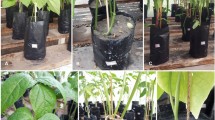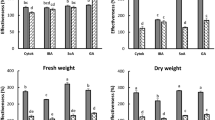Abstract
Fusarium solani infects roots of a number of different plant species and some strains produce Phytotoxins. F. solani f. sp. glycines, the causal organism of sudden death syndrome (SDS) of soybean (Glycine max), colonises soybean roots and produces toxin(s) that are translocated to leaves and cause intervienal chlorosis and necrosis. Several experiments evaluated the phytotoxicity of cell-free culture filtrates of F. solani f. sp. glycines by immersing cuttings of soybean seedlings into filtrates to determine what in vitro growth conditions alter the phytotoxicity, and to determine the specificity of toxicity of F. solani f. sp. glycines and other F. solani on cuttings of soybean and other legume species. Foliar disease severity ratings of soybean cuttings in cell-free culture filtrates diluted 25- and 50-fold were higher than when diluted 100-fold or more. Cell-free culture filtrates originating from cultures grown at 15, 20, and 25°C caused greater (P = 0.05) foliar disease severity ratings on cutting than when the fungus was grown at 30°C. Cell-free culture filtrates of F. solani isolates from cucumber (Cucumis sativus) and pumpkin (Cucurbita pepo) did not cause symptoms on soybean cuttings whereas filtrates of F. solani isolates obtained from other hosts caused some leaf chlorosis and/or necrotic spots. F. solani f. sp. glycines inoculated on eight legume species caused symptoms such as leaf chlorosis, defoliation, wilt or death on most of the species, but azuki bean (Vigna angularis), common pea (Pisum sativum) and vetch (Vicia sativa) were symptomless. Cell-free culture filtrates of F. solani f. sp. glycines caused foliar symptoms on all cuttings of legume species except for mung bean (Vigna radiata), although none of the symptoms matched the SDS symptoms observed on soybean foliage.
Similar content being viewed by others
References
Anderson TR, Tenuta AU (1998) First report of Fusarium solani f. sp. glycines causing sudden death syndrome of soybean in Canada. Plant Disease 82, 448.
Baker RA, Nemec S (1994) Soybean sudden death syndrome: isolation and identification of a new phytotoxin from cultures of the causal agent, Fusarium solani. (Abstr). Phytopathology 84, 1144.
Booth C (1971) ‘The germs Fusarium’ (Commonwealth Mycological Institute: Kew, Surrey, England)
Cucuzza JD, Waterson JC, Bernhardt EA (1992) Foot rot of tomato caused by Fusarium solani in California. Plant Disease 76, 101.
Gray LE, Achenbach LA (1996) Severity of foliar symptoms and root and crown rot of soybean inoculated with various isolates and inoculum rates of Fusarium solani. Plant Disease 80, 1197–1199.
Gray LE, Achenbach LA, Duff RJ, Lightfoot D (1999) Pathogenicity of Fusarium solani f. sp. glycines isolates on soybean and green bean plants. Journal of Phytopathology 147, 281–284. doi: 10.1046/J.1439-0434.1999.147005281.X
Hartman GL, Huang YH, Nelson RL, Noel GR (1997) Germplasm evaluation of Glycine max for resistance to Fusarium solani, the causal organism of sudden death syndrome. Plant Disease 81, 515–518.
Hartman GL, Noel GR, Gray LE (1995) Occurrence of soybean death syndrome in east-central Illinois and associated yield losses. Plant Diseased, 79 314–318.
Hartman GL, Sinclair JB, Rupe JC (1999) ‘Compendium of soybean diseases.’ (American Phytopathological Society: St Paul, MN)
Huang YH, Hartman GL (1998) Reaction of selected soybean genotypes to isolates of Fusarium solani f. sp. glycines and their culture filtrates. Plant Disease 82, 999–1002.
Jeffries CJ, Boyd AEW, Paterson LJ (1984) Evaluation of selective media for the isolation of Fusarium solani var. coeruleum and Fusarium sulphureum from soil and potato tuber tissue. The Annals of Applied Biology 105, 471–481.
Jin H, Hartman GL, Nickeil CD, Widholm JM (1996a) Characterization and purification of a phytotoxin produced by Fusarium solani, the causal agent of soybean sudden death syndrome. Phytopathology 86, 277–282.
Jin H, Hartman GL, Nickeil CD, Widholm JM (1996b) Phytotoxicity of culture filtrate from Fusarium solani, the causal agent of sudden death syndrome of soybean. Plant Disease 80, 922–927.
Kern H (1972) Phytotoxins produced by Fusaria. In ‘Phytotoxins in plant diseases’. (Eds RKS Wood, A Ballio, A Graniti) pp. 34–18 (Academic Press: New York)
Li S, Hartman GL, Widholm JM (1999) Viability staining of soybean suspension-culured cells and a seedling stem-cutting assay to evaluate phytotoxicity of Fusarium solani f. sp. glycines culture filtrates. Plant Cell Reports 18, 375–380. doi: 10.1007/S002990050589
Li S, Tarn YK, Hartman GL (2000) Molecular differentiation of Fusarium solani f. sp glycines from other F. solani based on mitochondrial small subunit rDNA sequences. Phytopathology 90, 491–497.
Melgar J, Roy KW (1994) Soybean sudden death syndrome: cultivar reactions to inoculation in a controlled environment and host range and virulence of causal agent. Plant Disease 78, 265–268.
Naef-Roth S (1972) Production and bioassay of Phytotoxins. In ‘Phytotoxins in plant diseases’. (Eds RKS Wood, A Ballio, A Graniti) pp. 49–69. (Academic Presss: New York)
Nakajima T, Mitsueda T, Charchar J (1996) First occurrence of sudden death syndrome of soybean in Brazil. Japan Agricultural Research Quarterly 30, 31–34.
Nemec S, Phelps D, Baker R (1989) Effects of dihydrofusarubin amd isomarticin from Fusarium solani on carbohydrate status and metabolism of rough lemon seedlings. Phytopathology 79, 700–705.
Ploper D (1993) Sudden death syndrome: new soybean disease in northeastern Argentina. Agroindustrial Advances 13, 5–9.
Roy KW (1997) Fusarium solani on soybean roots: nomenclature of the causal agent of sudden death syndrome and identity and relevance of F. solani form B. Plant Disease 81, 259–266.
Roy KW, Lawrence GW, Hodges HH, McLean KS, Killebrew JF (1989) Sudden death syndrome of soybean: Fusarium solani as incitant and relation of Heterodera glycines to disease severity. Phytopathology 79, 191–197.
Rupe JC (1989) Frequency and pathogenicity of Fusarium solani recovered from soybeans with sudden death syndrome. Plant Disease 73, 581–584.
Scherm H, Yang XB (1996) Development of sudden death syndrome of soybean in relation to soil temperature and soil water matric potential. Phytopathology 86, 642–649.
Sonogo S, Yang XB (2001) Relation of sand content, pH, and potassium and phosphorous nutrition to the development of sudden death syndrome in soybean. Canadian Journal of Plant Pathology 23, 174–180.
Author information
Authors and Affiliations
Corresponding author
Rights and permissions
About this article
Cite this article
Hartman, G.L., Huang, Y.H. & Li, S. Phytotoxicity of Fusarium solani culture filtrates from soybeans and other hosts assayed by stem cuttings. Australasian Plant Pathology 33, 9–15 (2004). https://doi.org/10.1071/AP03072
Received:
Accepted:
Issue Date:
DOI: https://doi.org/10.1071/AP03072




